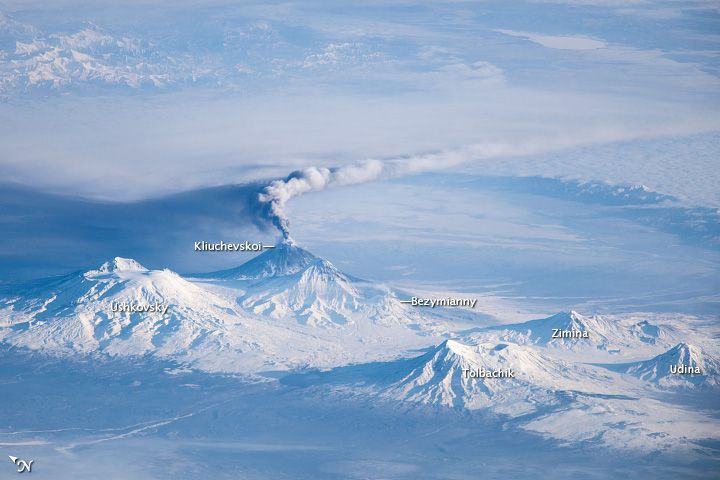Bird's-Eye View as Russian Volcano Blows

Russia's erupting volcanoes still look amazing even from thousands of miles away, aboard the International Space Station. An astronaut's view of erupting Klyuchevskoy volcano, snapped Nov. 16, reveals how the tall peak towers above the plains of Russia's Kamchatka Peninsula.
The image was taken when the International Space Station was more than 900 miles (1,500 kilometers) to the southwest of the volcano, from an altitude of 221 nautical miles (409 km), according to NASA's Earth Observatory.
The oblique, bird-eye view captured steam and ash billowing from Klyuchevskoy and streaming off into the distance. Five other snow-capped volcanoes — Bezymianny, Tolbachik, Udina, Ushkovsky and Zimina — cluster near Klyuchevskoy.
Klyuchevskoy is Kamchatka's tallest and most active volcano, rising more than 15,750 feet (4,800 meters) in a classic stratovolcano cone. Stratovolcanoes are steep-sided composites built from many layers of erupted material, including lava flows and ash. The peak has erupted more than 100 times in the past 3,000 years, according to the Smithsonian Institution's Global Volcanism Program database.
The latest eruption kicked off in August, with blasts heralded by puffy ash columns and earthquakes. Lava streamed from the peak on and off through October, sometimes fountaining from the summit.
Kamchatka's furious volcanic activity is due to the collision and sinking of tectonic plates eastward of the 775-mile-long peninsula (1,250 km). As the Pacific plate dives deep under either the Okhotsk or North American tectonic plates — depending on one's position along the peninsula — fluids escaping into the overlying crust help melt the overlying rock, creating magma. The buoyant molten rock eventually rises to the surface, forming volcanoes.
The collision zone is part of the Ring of Fire, a zone of volcanoes encircling the Pacific Ocean that result from similar tectonic settings, called subduction zones.
Sign up for the Live Science daily newsletter now
Get the world’s most fascinating discoveries delivered straight to your inbox.
Email Becky Oskin or follow her @beckyoskin. Follow us @OAPlanet, Facebook & Google+. Original article on LiveScience's OurAmazingPlanet.











